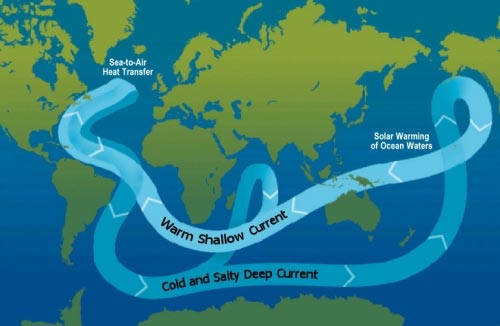Surface Ocean Currents
An ocean current can be defined as a horizontal movement of seawater in the ocean. Ocean currents are driven by the circulation of wind above surface waters, interacting with evaporation, sinking of water at high latitudes, and the Coriolis force generated by the earth’s rotation. Frictional stress at the interface between the ocean and the wind causes the water to move in the direction of the wind.

Ocean Circulation Conveyor Belt. The ocean plays a major role in the distribution of the planet’s heat through deep sea circulation. This simplified illustration shows this
Large surface ocean currents are a response of the atmosphere and ocean to the flow of energy from the tropics to polar regions. In some cases, currents are transient features and affect only a small area. Other ocean currents are essentially permanent and extend over large horizontal distances.
On a global scale, large ocean currents are constrained by the continental masses found bordering the three oceanic basins. Continental borders cause these currents to develop an almost closed circular pattern called a gyre. Each ocean basin has a large gyre located at approximately 30° North and one at 30° South latitude in the subtropical regions. The currents in these gyres are driven by the atmospheric flow produced by the subtropical high pressure systems. Smaller gyres occur in the North Atlantic and Pacific Oceans centered at 50° North. Currents in these systems are propelled by the circulation produced by polar low pressure centers. In the Southern Hemisphere, these gyre systems do not develop because of the lack of constraining land masses. Read more

